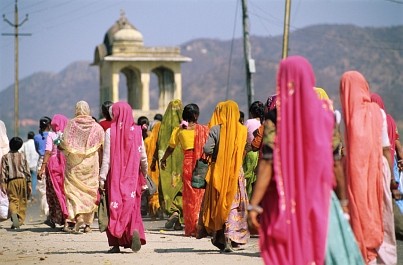 Jaipur is home to a surprising amount of attractions and a wealth of activities that rival that of any major city. Visitors to Jaipur can choose between an authentic visit full of local markets and temple hopping and a luxurious break in a five-star hotel complete with spa treatments. These options blend together to make this diverse city a great choice for people searching for all types of holidays.
Jaipur is home to a surprising amount of attractions and a wealth of activities that rival that of any major city. Visitors to Jaipur can choose between an authentic visit full of local markets and temple hopping and a luxurious break in a five-star hotel complete with spa treatments. These options blend together to make this diverse city a great choice for people searching for all types of holidays.Hinduism is the main religion in Jaipur, a thriving metropolitan city, and some areas in the city obey strict customs and etiquette that should be followed. Tradition Rajasthan men often wear turbans and women adorn ghagra-choli (type of sari) in public places. Although visitors are not expected to dress the same they are expected to cover up shoulders and avoid showing too much flesh. Bright colors are extremely popular.
Photographs should only be taken of places where they are permitted and if you wish to take a photograph of a local person you must get their permission first. Ensure taxi meters are switched on or a price is pre-agreed and only use tourist guides that hold a government approved card to ensure their authenticity and your safety.
Taxi drivers do not assume that you will leave a tip but the majority of other public services do expect a tip (10 percent) such as waiters, porters and guides. A tip before you receive a service will ensure that you get an enhanced level of service and it is common to ‘bribe' tour guides and hotel staff before rather than after service.
The currency in Jaipur is the Indian rupee (INR) and one rupee is divided into 100 paise. All of the primary worldwide currencies can be changed at banks as well as bureaux de change that can be found in all of the major tourist areas throughout the city. The airport is home to a 24-hour money change office as it is impossible to obtain rupees before your arrival in India.
There are a few ATMs but it is advisable to avoid them. They are a relatively new addition to the city and many foreigners suffer from theft and lost cards when using them. Traveler's checks and credit cards are the preferred way to pay and when possible it is best to carry money in small denominations as change can be hard to come by in the markets and the other tourist hotspots.
Jaipur's weather is what one would expect from a city located in a desert, with extreme climates endured throughout the year. Three main seasons visit Jaipur: the summer, the winter and the monsoon seasons. The summer runs from March to June and is extremely hot and dry with temperatures regularly hitting 45oC and the monsoon season follows until September, bringing with it dust storms and showers. Winter is then welcomed in November and although the days are pleasant and sunny, the temperatures dramatically drop during the night to as low as -5oC
. December through to February is arguably the best time to visit as the weather is at its least extreme and it is common for fog to shroud the city as night falls in the winter months, providing an eerie yet captivating sight.
The easiest way to travel the city is by local rickshaw or taxi but a price should always be agreed before you get in or the meter should be switched on. It is possible to hire public transport like this for the day if required and tour guides often double up as taxi or rickshaw drivers.
The majority of visitors to Jaipur enter the region by air and the city's busy air hub is only 13kms from the heart of Jaipur. Jaipur Airport was granted international status in 2005 and is able to accommodate 500 passengers per hour from cities such as London, Bangkok and Singapore.
Rail travel is also popular here and many choose to use the service that runs between Jaipur and Delhi that takes five hours as trains are more comfortable than buses and cheaper than flying.
Population: 2,000,000
Spoken languages: Rajasthani, Marwari, Hindi and English
Electrical: 240 Volts at 50 Hertz
Phone/calling code: +91 141
Find more information about Jaipur and hotels in the area:
Jaipur hotels | India hotels